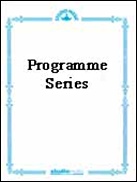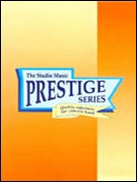Results
-
 £118.99
£118.99Jacques Brel Toujours! Wind Band Set (Score & Parts)
The French-speaking Flemish singer, composer and lyricist Jacques Brel was born in Brussels in 1929. In the 1950s, he broke away from his bourgeois social background of his family and started an artist's life in Paris, where he initially wrote chansons and earned a living by performing in small cabarets and bars. Over the following years he achieved worldwide fame with his chansons, which were alternately harsh and melancholic Roland Kernen has selected a number of the wonderful chansons written by this most creative artist to produce this unforgettable chanson medley. 0:07:25
Estimated dispatch 7-14 working days
-
 £149.99
£149.99Land of Legends Wind Band Set (Score & Parts)
In 'Land of Legends' German composer Andreas Ludwig (what's in a name) Schulte takes you along to the fictional world of legends, myths and fairy tales. The introduction to the first part (The Castle) describes the majestic contours of the scene of action. Its instrumentation (horns) immediately makes you imagine being in Medieval spheres. The addition of trenchant copper instruments even gives the part a heroic tinge. After entering through the gate, a lot of hustle and bustle appears to be going on in the courtyard. Pages, squires and soldiers are busy attending to their arms. Beer is being brewed, flax is being spun, cattle are being tended and some craftsmen from neighbouring villages are busily at work. In the upper chamber of the round tower lives an old man (The Old Wizard). He hardly ever comes out, and nobody knows exactly what he is doing. It is said that he is engaged in wizardry and magic. It is all very mysterious. There are also festivities, some of them sober, others exuberant. The wedding in the third part is celebrated in a grand manner. With a flourish of trumpets, the bride makes her entrance at the hand of her father. Afterwards, at the party there is dancing to the music played by minstrels and of course a plentiful banquet follows. 11:00
Estimated dispatch 7-14 working days
-
 £59.95
£59.95LAST LINCOLNSHIRE POACHER (Programme Concert Band) - Stubbs, Duncan
Another winner from Duncan Stubbs! This time he recreates the famous poacher out again, at the dead of night - until he hears sounds of the police around him. Does he escape? . . . . . . .
Estimated dispatch 7-14 working days
-
 £65.00
£65.00The Ringing Isle (Concert Band - Score and Parts) - Dove, Jonathan - Littlemore, Phillip
Handel called Britain 'the ringing isle' because when he moved to London, he heard bells ringing everywhere: great bells in church towers, and handbells in some of the first private houses he visited. The sound of people 'ringing the changes' is a peculiarly British sound of celebration, and it seems a good starting point for a piece celebrating British musical life. Within The Ringing Isle, Dove incorporates some traditional change-ringing patterns, from 'Grandsire Doubles', 'Oxford Treble Bob Minor' and his own version of 'Plain Bob Major'. Handel's phrase also conjures up an image of a magical island, and so this is how Dove envisaged how it must have been to approach Britain from an ocean voyage.
Estimated dispatch 7-14 working days
-
 £149.99
£149.99The Road to the West Wind Band Set (Score & Parts)
As he did before in the often played and commonly appreciated 'Lord Tullamore', in which he poetically depicted the landscape and the cultural elements of a small Irish village, in his composition 'The Road to the West' Carl Wittrock has sketched pioneer existence in America in a cinematic manner.In 'The Road to the West' the composer has tried to capture images of pioneer life during the period dating from 1850 to 1890, the days of the so-called Wild West.In those days, the Wild West used to be the territory west of civilization, the domain of cowboys, trappers, and other fortune hunters. In short, ample ingredients for a captivating story.In the first scene a lonely adventurer struggles against nature and the elements. After an exciting adventure he passes through 'the Plains', where majestic views alternated by colossal mountain ranges display an almost unimaginable beauty.After weeks of isolation civilization is reached again. 'The Saloon' is the perfect meeting place - here news is exchanged and hilarious scenes regularly take place. 08:00
Estimated dispatch 7-14 working days
-
 £154.99
£154.99The Verdict (Concert Band - Score and Parts)
The Verdict shows Otto Schwarz great skill at composing Concert Band items in his typical imaginative film musical style. It tells the tale of two brothers who differed greatly, one was handsome and the other a huntchback. The huntchback stabbed his brother after he had taken his bride from him and for this was sentenced to death. He was given a last minute reprise when he told of a spring that would end the local drought. An epic tale of love and revenge! 11:00
Estimated dispatch 7-14 working days
-
 £23.95
£23.95TUBA CONCERTO (Fraser) (Prestige Tuba/Concert Band Extra Score) - Fraser, Bruce
On being asked by James Gourlay, one of the world's leading tuba players, to write this work the composer was given a free hand to write whatever he wanted. A rare request in a commission! To start he created a note-row from t he musical letters of James' name giving a minor seventh chord and an added flattened fifth. From this point everything went into the pot bringing out simplet tunes, cadenzas, and even muti-phonics! A real challenge for the performer but joy for the listener! Duration: 12:31 Grade 4-5 (Solist 5++)
Estimated dispatch 7-14 working days
-
 £119.95
£119.95TUBA CONCERTO (Fraser) (Prestige Tuba/Concert Band) - Fraser, Bruce
On being asked by James Gourlay, one of the world's leading tuba players, to write this work the composer was given a free hand to write whatever he wanted. A rare request in a commission! To start he created a note-row from t he musical letters of James' name giving a minor seventh chord and an added flattened fifth. From this point everything went into the pot bringing out simplet tunes, cadenzas, and even muti-phonics! A real challenge for the performer but joy for the listener! Duration: 12:31 Grade 4-5 (Solist 5++)
Estimated dispatch 7-14 working days
-
 £174.99
£174.99Two Symphonic Interludes Wind Band Set (Score & Parts)
Based on the poems by German poet Carl Hauptmann (late Romanticism) and the English poet William Wordsworth (early Romanticism). Carl Hauptmann was in poor health as a child, but highly intelligent. He studied philosophy, psychology and biology. In the latter he was admitted to the degree of doctor. His marriage provided financial independence, so that he could focus on his studies. Hauptmann wrote various novels, plays, poetry and scientific works. Night Twilight floats above the valley's night mists are hanging, there's a whispering brook. Now the covering veil is lifting quite: come and look! See the magic land before our gaze: tall as dreams the silver mountains stand, crossed by silent silver paths shining from a secret land. Noble, pure, the dreaming country sleeps. By the path the shadow black and hogh of a beach. a wisp of a white smoke creeps to the dark'ning sky. Where the valley is the darkest hued countless little lights shine silently. O my soul! Drink of solitude! Carl Hauptmann Wordsworth 'introduced' a new type of poetry, based on the speech of the common man. This was his answer to the poetry of the classicism which was bound by rigid rules. His definition of poetry was: the spontaneous overflow of powerful feelings from emotions recollected in tranquility. My heart leaps up when I behold a rainbow in the sky My heart leaps up when I behold A rainbow in the sky: So was it when my life began. So is it now I am a man. So be it when I shall grow old, Or let me die! The Child is father of the Man. And I could wish my days to be Bound each to each by natural piety. William Wordsworth In a truly poetic manner Harrie Janssen has transformed the contemplative thoughts of the poets into two compositions for Concert Band. 10:45
Estimated dispatch 7-14 working days
-
 £122.00
£122.00Ouvertre in Es-Dur - Stephan Jaeggi
As part of the year 2023, dedicated to Swiss composers, the Swiss Wind Band Association has commissioned Gauthier Dupertuis to write a new orchestration of the Overture in E-flat major by Stephan Jaeggi. Indeed, an update of the instrumentation was necessary for the interpretation of this work with modern orchestras.Therefore, the orchestration that Gauthier Dupertuis proposes and which he wanted to be faithful to the original while meeting current standards, will allow today's orchestras to performthis piece of classical-romantic inspiration.Stephan Jaeggi was a Swiss composer and conductor who was born into a large family in Fulenbach (Canton of Solothurn) in 1903. He began playing the clarinet at the age of 13, then studied music at the Basel Conservatory and attended his military training with the Swiss Army Band. Thereafter, he became the conductor of several wind orchestras. In this role, and also that of a composer, Stephan Jaeggi went on to achieve great success. His early death in 1957 put a premature end to Stephan Jaeggi's creative life. All the more reason why his work lives on with unbroken power to this day.
Estimated dispatch 7-14 working days
